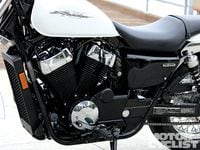Ordinarily, the motorcycle industry is in a head-spinning technological arms race. A mad dash to feed technophiles their traction control and XM Radio; serve up ego-maniacs their astronomical engine-displacement figures; and deliver to mobile couch potatoes their heated seats. But there must be a few people like me left out there-people who just plain like to jump on something and ride it. People who feel that going 'round corners is the height of pleasure, and a good, torquey pull off the line is enough to make you halfway forget about who got voted off American Idol last Wednesday. Yes, there must be. Otherwise, Honda wouldn't have created the Shadow RS.
For the past 27 years, Honda has marched to the beat of a hypnotically steady drummer, pumping out one Shadow after another in the cruiser mold-complete with stretched forks, forward footpegs and a stooped-back riding position. But this year, something different happened: The Shadow became sporty, and not just through a deliberate shift in brochure lingo. The change is real.
I jumped on and found that the Shadow's athleticism begins with a more "standard-ish" seating position. It's got higher footpegs that sit closer to the seat, which make you feel stable in the saddle. You become a pilot, rather than a passenger. The whole riding position-from the feet, to the bum, to the hands-feels as natural as an office chair, desk and keyboard. And I mean that in a good way. The Shadow's low seat height is a boon to newer and shorter riders, but it fits taller folks fine (I'm 5-foot-10). The new peg position also increases cornering clearance, so a sporting slalom through the canyons doesn't necessarily translate into a sparks-flying, hard-parts-grinding slow race.
Despite weighing more than 500 pounds full of fuel, the RS feels nimble and light. On the road it turns easily and quickly, and in slow-speed maneuvers its low center of gravity makes it easy to control. Honestly, I thought there was a little romance at the junction of this bike's power and weight. Although Honda doesn't make power claims, a little bird told me the 745cc V-Twin pumps out around 42 horsepower and 45 lb.-ft. of torque. That doesn't sound like much, but it felt ideal in every situation: pulling away from stop lights, merging with freeway traffic and carving canyon sweepers.
The exhaust sounds just rumbly enough to make you nod your head, but not so out-rageous to make your neighbors shake theirs. Honda's PGM-FI (Programmed Fuel Injection) system makes for smooth power even when you climb in elevation, along with greater fuel economy and lower emissions than a comparable carbureted model. As one might expect from a Honda, the transmission is flawless and shifted without a single hiccup. Plus, the torquey power is predictable for newcomers and fun for veteran riders, because it provides a strong spread of oomph over a broad rpm range. Could Honda have put a few more horses in this "sporty" Shadow? Sure, but I never missed them.
Switching focus from going to stopping, the front brake lever activates a single disc, while the rear pedal triggers an old-school drum. While certainly not the most high-tech braking system, these do you a serious solid when you've got to get stopped. The sturdy 41mm fork held up to the hard-braking punishment and offers 4.6 inches of reasonably plush travel, while the preload-adjustable twin shocks provide 3.5 inches.
As for looks, the RS combines cruiser details with a sporty-standard profile. Honda tells us that the classic 2.8-gallon roadster tank and seat shape are inspired by the world of flat-track racing, and yes, there's a hint of Harley-Davidson Sportster. At a claimed 56 mpg, that should allow around 150 miles between fill-ups. Then, from the cruiser family tree, the Shadow gets its wire wheels, round headlight and touch of chrome, which contrast nicely with the Pearl White or Metallic Gray paint colors. The single circular gauge posted ahead of the fuel tank adheres to Honda's homage to simplicity and functionality, telling you everything you need and nothing you don't.
And that, in a nutshell, pretty much describes this bike: everything you need and nothing you don't. For just about everybody who likes riding motorcycles.
tech
SPEC
**Evolution
** The Shadow emerges from the, ahem, shadows.
**Rivals
** Harley-Davidson Sportster 883, Boulevard M50, Kawasaki Vulcan 500 LTD, Star V-Star Classic.
Verdict 3.5 stars out of 5
Honda builds a Sportster!















/cloudfront-us-east-1.images.arcpublishing.com/octane/G4MG6OUCJNBSHIS2MVVOTPX65E.jpg)
/cloudfront-us-east-1.images.arcpublishing.com/octane/IIGGWFOTOJGB7DB6DGBXCCMTDY.jpg)
/cloudfront-us-east-1.images.arcpublishing.com/octane/QSTCM6AVEZA5JJBUXNIQ3DSOF4.jpg)
/cloudfront-us-east-1.images.arcpublishing.com/octane/U4I7G625B5DMLF2DVIJDFZVV6M.jpg)
/cloudfront-us-east-1.images.arcpublishing.com/octane/B6XD6LS6IVCQPIU6HXDJSM3FHY.jpg)
/cloudfront-us-east-1.images.arcpublishing.com/octane/ICL63FEDDRDTTMINYICCEYGMDA.jpg)
/cloudfront-us-east-1.images.arcpublishing.com/octane/FCGZHQXRBZFLBAPC5SDIQLVF4I.jpg)
/cloudfront-us-east-1.images.arcpublishing.com/octane/WNOB6LDOIFFHJKPSVIWDYUGOPM.jpg)

/cloudfront-us-east-1.images.arcpublishing.com/octane/X33NU3E525ECRHXLNUJN2FTRKI.jpg)
/cloudfront-us-east-1.images.arcpublishing.com/octane/6KKT5NNL2JAVBOXMZYS5ZO76YA.jpg)
/cloudfront-us-east-1.images.arcpublishing.com/octane/J5RKG5O455GMPGQRF2OG6LRT7A.jpg)
/cloudfront-us-east-1.images.arcpublishing.com/octane/GX2CIZKQVRH2TATDM26KFG2DAE.jpg)
/cloudfront-us-east-1.images.arcpublishing.com/octane/ZWIDYSAKQZHD5BHREMQILXJCGM.jpg)
/cloudfront-us-east-1.images.arcpublishing.com/octane/CYUHJZCTSJCH3MRAQEIKXK7SCQ.jpg)
/cloudfront-us-east-1.images.arcpublishing.com/octane/LKOFINY56FCXJCANJ5M7ZDQUBY.jpg)
/cloudfront-us-east-1.images.arcpublishing.com/octane/4NBPDACMWJH63JQYJVK3QRBDZI.jpg)
/cloudfront-us-east-1.images.arcpublishing.com/octane/KKHQHRR3FJGX7H2IPU6RALMWG4.jpg)

/cloudfront-us-east-1.images.arcpublishing.com/octane/5IOFS5JAE5FOXMNA23ZRAVVYUU.jpg)
/cloudfront-us-east-1.images.arcpublishing.com/octane/CGXQ3O2VVJF7PGTYR3QICTLDLM.jpg)

/cloudfront-us-east-1.images.arcpublishing.com/octane/OQVCJOABCFC5NBEF2KIGRCV3XA.jpg)
/cloudfront-us-east-1.images.arcpublishing.com/octane/OPVQ7R4EFNCLRDPSQT4FBZCS2A.jpg)